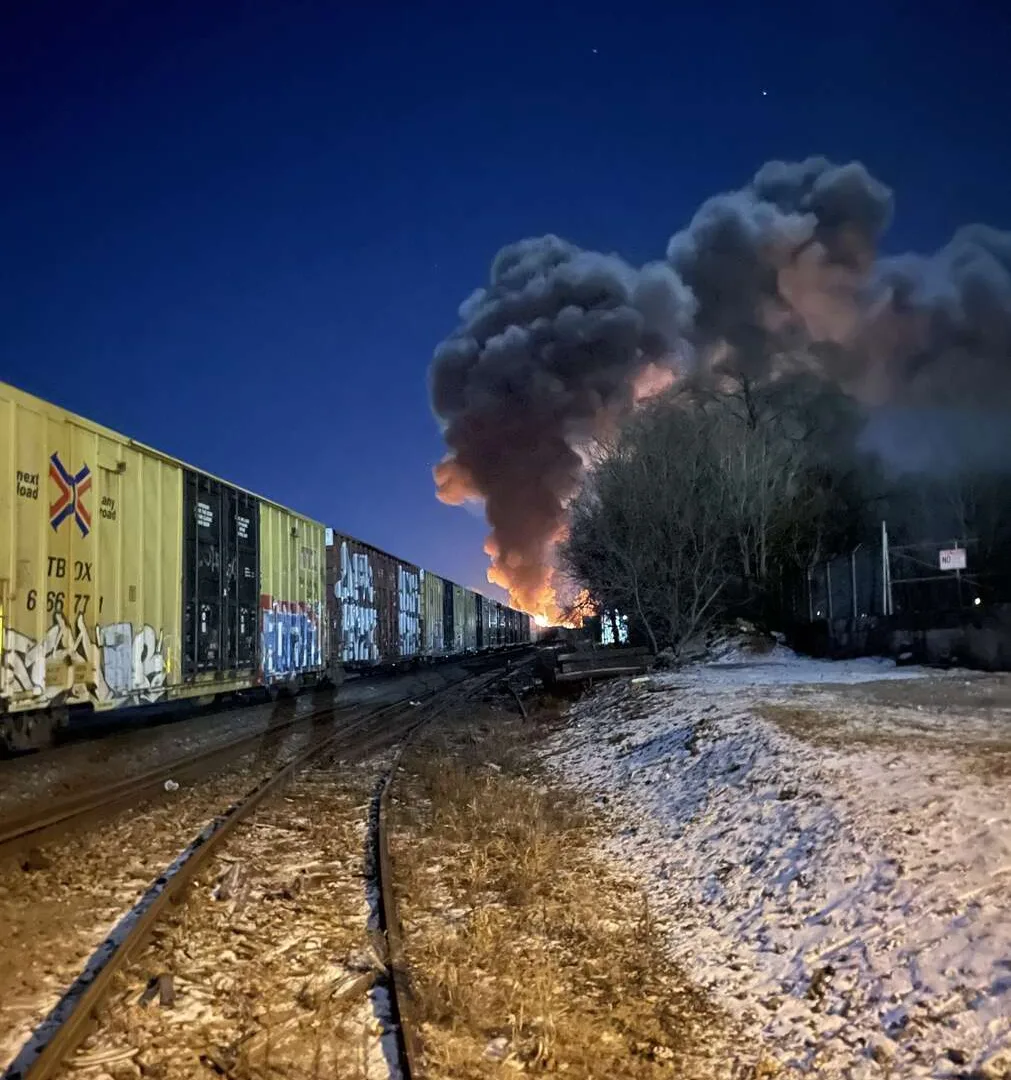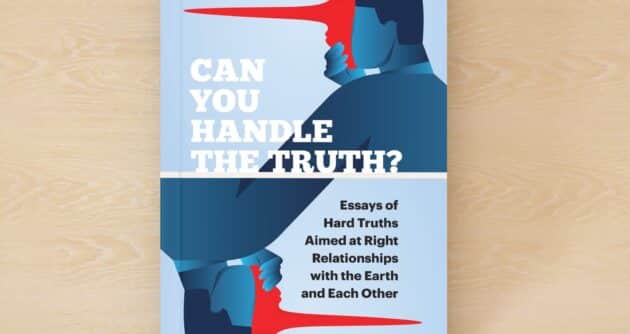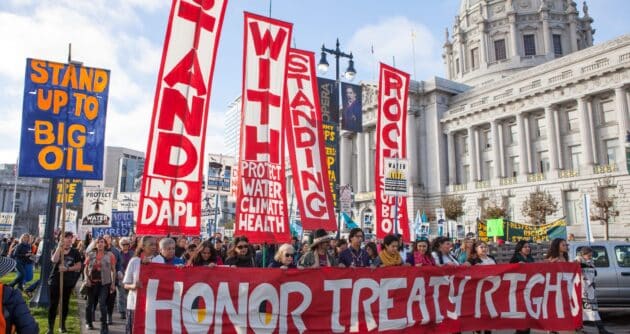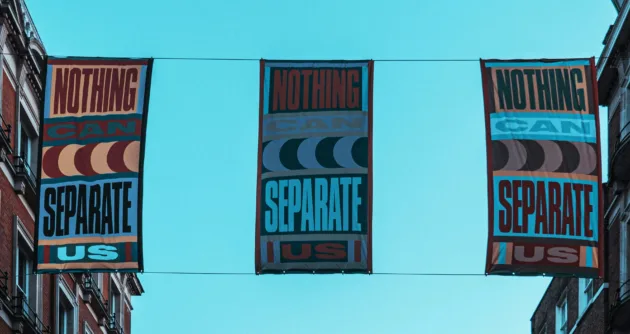Feature photo by Hayley Heckert
Written by Tish O’Dell and Chad Nicholson – This is a more in-depth follow up to the piece recently published In These Times.
Rolling catastrophes like the train derailment in East Palestine, Ohio, on February 3 are unfortunately too similar to the same stories that we at the Community Environmental Legal Defense Fund (CELDF) have been privy to for over 25 years. Hearing bad news on a daily basis hardens you, but this man-made disaster struck very close to home for both of us. Chad lives one hour southeast of East Palestine and Tish one hour northwest. As Community Rights and Rights of Nature organizers and activists, we are well aware that every environmental disaster impacts us all, but this one hit closer than most.
As events unfolded, it became clear that this story, like so many others, is following the same sad script.
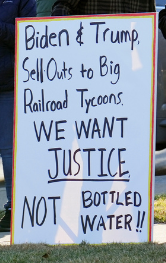
We understand this is a horrific event and we feel sorrow and empathy for the people, plants, and wildlife that have been and will continue to be harmed by this disaster. We also feel a strong obligation to dissect this particular disaster and remind people that, like Bill Murray in the movie Groundhog Day, much of what is happening in East Palestine is a never-ending replay of similar events we have observed in hundreds of other communities across the nation.
The hope that drives our work at CELDF is that more of us finally wake up and realize that disasters like these keep happening because the system – the train – keeps rolling, exactly as it was designed to function. It may not always be on time, but it keeps chugging along, permitting and legalizing the harms to keep happening, with the consequences held by communities and nature and the spoils going to the economic elites.
The Regulatory Boxcar
We are taught that our government and its agencies are created to serve us, the people. We’re told that agencies like the Environmental Protection Agency, the Department of Transportation, the Federal Railroad Administration, and an alphabet soup of other local, state, and federal agencies exist to ensure our safety and wellbeing.
Just as trains are engineered for a specific purpose, so are our regulatory agencies. Few people are aware that the first regulatory agency in this country – the Interstate Commerce Commission in 1887 – was created at the insistence of, ironically, the major railroad corporations, as a way to limit public oversight and take the heat off the industry’s increasingly brazen assaults on communities, workers, and the environment.
Immediately after the derailment in East Palestine, there was confusion from reporters, first responders, and local, state and federal officials about exactly what chemicals were even in the train’s burning cars. Yet, right on cue, despite not knowing what effects the various chemicals could have within an explosive situation, the EPA reported that the air and water was safe to breathe and drink.

As more reports trickled out in the days that followed, we learned that train cars were carrying at least five toxic chemicals (vinyl chloride, ethylene glycol monobutyl ether, butyl acrylate, ethylhexyl acrylate, and isobutylene), despite those chemicals not being classified as “highly hazardous” by Norfolk Southern representatives. According to government and scientific data sheets, exposure can cause multiple forms of cancer and other serious health issues. First responders had little idea what they were dealing with.
Many people we work with wonder, “how can this be?” How is it that corporations seem to be able to literally roll into our communities without accountability to those who live there, while also not being accountable to the government agencies who apparently oversee them? The finger pointing about who’s responsible – whether the corporation, the government agencies, elected officials, etc. – has been almost as sad as the harms inflicted on the community and surrounding natural areas.
Listening to the Experts: Whose Experts and for Whose Benefit?
In the days following the derailment, Governor DeWine of Ohio, in consultation with Norfolk Southern representatives, greenlighted a plan to blow holes in five of the cars containing toxic chemicals, which would lead to a “controlled burn.” Residents in multiple nearby communities were ordered to evacuate. According to an article in CounterPunch, “It’s unclear how much the rail company consulted with the EPA before making this fateful decision, but soon after the fire started a black mushroom cloud of smoke, ash and debris rose over the town and hovered there for the next few days. The air tested positive for phosgene, hydrogen chloride, VOCs (volatile organic compounds) and particulate matter for at least the next 72 hours.”
This decision was defended by public officials and Norfolk Southern as the “safest way” to handle the situation. But was it? Shouldn’t the residents affected by the harm have a right to know if other experts were consulted besides the railroad, if any? In such a dire emergency with such deadly consequences, shouldn’t as many experts and opinions be considered, with all information available to those affected? And then, who gets to make the final decision? Most of us would likely get a second opinion if presented with such a devastating diagnosis.

Efforts by the news media to get answers were also stymied. At a press conference with Governor DeWine and other officials, a reporter for NewsNation was shoved to the ground and then arrested for…reporting the news. Though the charges were later dismissed, this was yet another illustration of how the government and the corporation were working to limit access to information.
The controlled burn was carried out on Monday February 6, and the trains began running again on February 8, according to a Norfolk Southern message to customers. As thousands of dead fish floated in local waterways, and nearby residents were reporting ill health, as well as dead pets and animals, the railroad chugged along to get back to business as usual.
It’s About the Economy, Stupid
Since this country’s founding, our system of government has placed profits and property interests over people and planet. The derailment in East Palestine illustrates this clearly. For over 150 years, railroad workers have been telling employers like Norfolk Southern and the government that their working conditions are deplorable and dangerous.
With deregulation of the industry in the 1980’s, which included Wall Street mergers and “short term profit imperatives”, trains have been getting longer and longer while the number of employees get smaller and smaller. Norfolk Southern and other railroad corporations, meanwhile, continue to record massive profits. Norfolk Southern reported $4.8 Billion in profits for 2022, a record year. Compare that to the $3.4 million the company has offered to residents of the community.

Governmental fines are laughable when compared to the corporation’s profits. In industries like these, it’s easier, and more profitable, to first act recklessly and then ask for forgiveness later.
The railroad corporation is currently saying all the right things to try and diffuse the bad publicity. The corporate executives “promise to make this right,” and provide whatever it takes to make the community safe again, including monetary support.
Lawyers and NGOs are also swooping into the community, picking at the debris with promises of class action lawsuits and big settlements. Yet based on past catastrophes of this magnitude, no matter how much money is distributed in the end, harms have already happened, and the long-term consequences are still difficult to assess.
In the words of hazardous materials expert and retired Youngstown Fire Chief Sil Caggiano, “We basically nuked a town with chemicals so we could get a railroad open.”
Nature Does Not Recognize Human Boundaries
On Monday February 6, Ohio Governor Mike DeWine held a press conference in East Palestine to inform the community and the media about the controlled burn that was scheduled. He showed a map of the area with two circles, one red and one orange. If you were in the red circle, you were told it was a matter of life and death that you leave. If you were in the orange circle, it was recommended that you leave. Most humans heard the message, but did anyone notify the birds, the fish, the animals and all other life in those areas?
And what about rain and wind, which do not abide by the circles drawn on human maps? One local headline asked, “Is there acid rain in Ohio?” Under our current system, we are too often taught only to look to experts to confirm our common sense. “Acid rain could have formed after the controlled release and burn of chemicals on February 6,” Kevin Crist, professor of chemical and biomolecular engineering and the director of the Air Quality Center at Ohio University, said. “If in that plume you got moisture there may be a local effect on the trees and stuff in that area, but it would be gone now.” Crist goes on, “If it [acid rain] did form and fall, it would have most likely occurred downwind of East Palestine.” At least there’s good news for people and ecosystems upwind!

The consequences continue to have impacts to humans and nature far beyond those circles drawn on a map. Over 2,980 tons of contaminated soil and 4.85 million gallons of contaminated water have already been removed, sent to dumping grounds that will affect other communities somewhere else. Recently, the EPA ordered Norfolk Southern to stop removing contaminated soil due to increasing concerns from communities located near dump sites that were not willing to accept the toxic waste. Then, a few days later, EPA announced that the contaminated water and soil will be sent to four locations in Indiana and Ohio, instructing us to trust their years of experience in handling toxic waste. And most recently, the EPA has told states that they cannot refuse shipments of waste from East Palestine.
On February 17, DeWine spoke about a plume of butyl acrylate – a chemical known to cause skin rashes and lung damage – that was released into the Ohio River (the most polluted river in the United States according to the EPA) due to the derailment. It has “completely dissipated” according to the latest testing, DeWine said. “We do believe that there’s no reason to be concerned about water from the Ohio River and there’s never really been a reason to be concerned.” Even still, DeWine stated that some municipal water systems will close off their intakes, but the fish, birds, plants and other wildlife have no valves to close.
In the words of the Lorax, “who speaks for the trees?”
The Final Report
We doubt we’ll learn much more from the final government reports on the derailment. Many lawsuits have already been filed, so there may be other information we receive, though likely years down the line. Many of those lawsuits will also likely be settled, which means that evidence, depositions, and other information that comes out through court proceedings will likely be sealed.
We will “learn,” yet again, that protecting commerce, profits and property is placed as the top priority.
As people develop illnesses and maybe even die, will anyone even notice? Maybe in a decade or so courageous community activists will start to put the pieces together, and fight for the government agencies to do studies to connect the dots. Maybe the area will be declared a “cancer cluster” or maybe a “superfund site,” of which we already have so many.

Maybe East Palestine will be just another story added to the long list of other corporate homicides, which include (among many many others): Love Canal Niagara Falls, New York; Times Beach Missouri; Middlefield Ohio; Flint Michigan; Gulf Coast Louisiana.
As Community Rights and Rights of Nature activists and organizers, we hope not. Our work is about helping people connect some of these events and focus on systemic change to finally break the cycle and get out of Groundhog Day once and for all. To do this we must first acknowledge the roots of the problem, and then re-imagine and build a new system.
Any new system we create must be one where the people get to not only have a voice in the process, but actually have binding decision making authority over the issues that will impact the human and natural communities. A system where community protection laws and policies are paramount. A system where corporations and elected officials are directly accountable to those they serve. A system where corporations and policymakers need to prove the safety of any project before it rolls into town, and ask for permission first…and not forgiveness later.
It’s time to abandon where this track leads, and come together to lay a whole new foundation that places people, communities, and nature as its highest priority.
